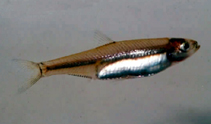| Diagnosis: |
Dorsal spines (total): 0-0; Dorsal soft rays (total): 11-15; Anal spines: 0-0; Anal soft rays: 13-17; Vertebrae: 38-40. Diagnosis: Body relatively elongate; belly rounded, without pre-pelvic scutes, but a pelvic scute present with slender lateral arms; gillrakers reduced in number, 15-19 gillrakers on lower limb of first arch; pelvic fin with 1 unbranched and 7 branched finrays, a little anterior to dorsal fin origin; last two anal finrays not separate from others (Ref. 33664). It is distinguished from Sauvagella madagascariensis by lower vertebral number, 38-40 vs. 41-43; deeper body, 20.8-27.4% of standard length vs. 15.8-21.1%; a shorter snout, 18.5-26.6% of head length vs. 26.2-33.7%; and a lower anal fin ray count, 13-17 vs. 17-19 (Ref. 33664).
Description: Robust, relatively deep-bodied, even in small specimens, with a straight dorsal profile; ventrum markedly rounded to caudal peduncle; snout short and straight, with slightly upturned mouth; gape inclination approximately 40° to horizontal; upper jaw to vertical through anterior margin of orbit (Ref. 33664). Pre-maxilla with short dentigerous arm, extending over anterior third of maxillary shaft; pre-maxillary teeth few, 5-8, small unicuspids in single row; maxilla usually with smooth ventral flange, slightly serrate in large individuals; single, tear-shaped posterior supramaxilla; lower jaw teeth few, in single row of small unicuspids restricted to region of symphysis (Ref. 33664). Relatively few robust rakers on lower limb of first arch, 15-19; 7-9 hypobranchial rakers, mostly blunt and conical, increasing in length to ceratobranchial; 10-12, elongate, widely spaced rakers on ceratobranchial; usually 1 raker in angle of arch, included in count of lower limb, and 9-12 epibranchial rakers; a row of short blunt rakers on inner face of third epibranchial (Ref. 33664). Dorsal fin short-based, relatively tall, usually with 3 unbranched and 8-12 branched rays; entire fin situated anterior to anal origin; anal fin with 3-4 unbranched and 11-14 branched rays, origin posterior to end of dorsal; ventral margin of anal broadly incised; pectoral fin short, with 11 rays, reaching midway to pelvic fin origin; pelvic fin with 1 unbranched and 7 branched rays, its insertion anterior to dorsal fin origin; caudal fin forked (Ref. 33664). Scales are cycloid (Ref. 33664). Belly rounded, lacking pre-pelvic scutes and post-pelvic scutes; pelvic scute with slender lateral arms (Ref. 33664). Vertebral counts 38-40 with 20-22 precaudal and 18-19 caudal centra; first supraneural bone flat and platelike, remaining 12-13 short and tubular; hyoid arch with 5 branchiostegal rays, first is narrow and filamentous, the second variously expanded, and rest are flat and broad; a single row of small teeth on ectopterygoid, small toothpatch on median face of endopterygoid, rodlike palatine edentate even in large individuals (Ref. 33664).
Colouration: In life, uniformly pale creamy yellow with some silvery iridescence on chest and ventrum (Ref. 33664). Preserved specimens are pale cream or dark yellow with faint pigment ringing dorsal scale margins, slightly darkening the dorsum; a trace of a thin midlateral band of dark pigment restricted to posterior half of body; dorsal, anal and caudal fins with a line of dark pigment along base at body wall; pupil situated more-or-less in mid-eye, iris silver or black (Ref. 33664). |

